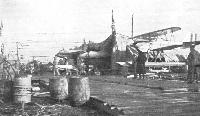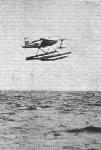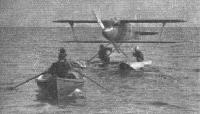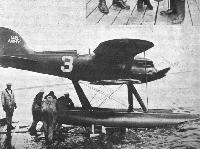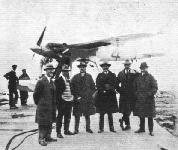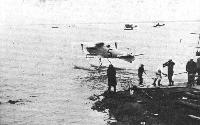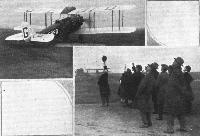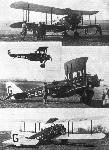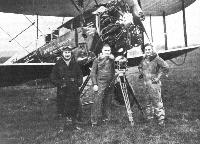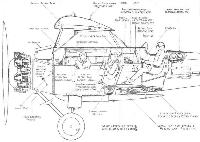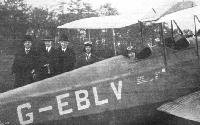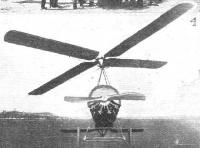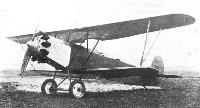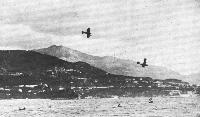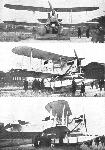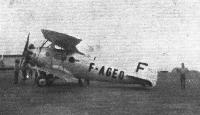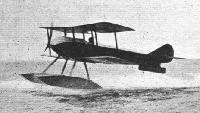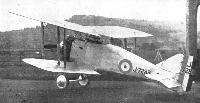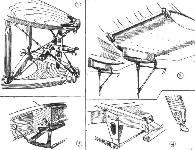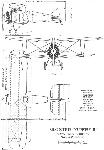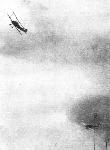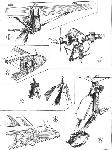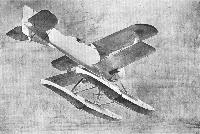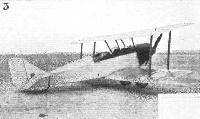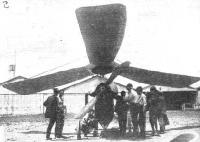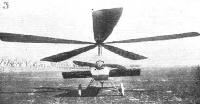Фотографии
-
ON THE SLIPWAY AT BAY SHORE PARK: In the foreground is a U.S. Navy "dog ship," and farther back the Supermarine-Napier S.4, while in the background may be seen the Gloster-Napier III.
Самолёты на фотографии: Curtiss F6C / P-1 / Hawk / Model 34 - США - 1925Gloster I - III - Великобритания - 1923Supermarine S.4 - Великобритания - 1925
-
Регистрационный номер: G-EALQ THE 1919 SCHNEIDER CUP CONTEST: Another British entry, the Fairey seaplane (Napier "Lion"), piloted by Lieut.-Col. Vincent Nicholl.
Самолёты на фотографии: Fairey Fairey III - Великобритания - 1917
-
THE SCHNEIDER CUP WINNER: The Curtiss-Army Racer which Lieut. "Jimmie" Doolittle, here seen standing on one of the floats of his machine, flew to victory at the magnificent average speed of 232-573 m.p.h.
Самолёты на фотографии: Curtiss R2C / R3C - США - 1923
-
THE SCHNEIDER CUP RACE: Doolittle taking off at the start of the race which he won in such splendid fashion.
Самолёты на фотографии: Curtiss R2C / R3C - США - 1923
-
THE SEVENTH SCHNEIDER CUP CONTEST, 1923 : This time the trophy was secured by America. Above is shown Lieut. D. Rittenhouse winning, at Cowes, with a speed of 177-38 m.p.h., on the Navy-Curtiss racer. Inset, the machine taking off.
Самолёты на фотографии: Curtiss R2C / R3C - США - 1923
-
WINNER OF THE 1925 SCHNEIDER TROPHY RACE: The machine in flight during the race
Самолёты на фотографии: Curtiss R2C / R3C - США - 1923
-
THE SCHNEIDER CUP RACE: The photograph shows Lieut. Ofstie leaving the slipway at Bay Shore Park for the navigability trials on October 23.
Самолёты на фотографии: Curtiss R2C / R3C - США - 1923
-
THE SCHNEIDER CUP RACE: In the photograph is seen the Curtiss-Navy Racer No. 1 shortly before the start of the actual race on October 26.
Самолёты на фотографии: Curtiss R2C / R3C - США - 1923
-
WINNER OF THE 1925 SCHNEIDER TROPHY RACE: Lieut. "Jimmie" Doolittle's Curtiss-Army Racer, on which he won the race at an average speed of 232-573 m.p.h.
Самолёты на фотографии: Curtiss R2C / R3C - США - 1923
-
THE SCHNEIDER CUP RACE: The three Curtiss Racers on the beach at Bay Shore Park. Lieut. Doolittle's famous winning machine is the one in the background.
Самолёты на фотографии: Curtiss R2C / R3C - США - 1923
-
AT BAY SHORE PARK: The group in front of the Supermarine-Napier S.4 includes Lieut. Guy Townsend (U.S. Navy), Bert Hinkler, R. J. Mitchell, T. Hildebrandt (of the Baltimore Flying Club), Capt. Biard, and Major W. D. Tipton, Secretary of the Baltimore Flying Club
Самолёты на фотографии: Supermarine S.4 - Великобритания - 1925
-
AT BAY SHORE PARK: the machine leaving the slipway for its first test flight.
Самолёты на фотографии: Supermarine S.4 - Великобритания - 1925
-
THE SCHNEIDER CUP RACE: Capt. Broad's Gloster-Napier III leaving the slipway or its first test flight. In the background may be seen the Supermarine-Napier S.4, and, on the right, some of the American seaplanes which were to take part in the demonstration planned for Schneider Cup day.
Самолёты на фотографии: Gloster I - III - Великобритания - 1923Supermarine S.4 - Великобритания - 1925
-
THE 1925 SCHNEIDER CUP RACE: This side view of the British challenger, the Supermarine-Napier S.4. The Supermarine-Napier S.4 holds the world's speed record for seaplanes with 226-752 m.p.h.
Самолёты на фотографии: Supermarine S.4 - Великобритания - 1925
-
AT BAY SHORE PARK: the Napier engine of the Supermarine-Napier S.4 being run up
Самолёты на фотографии: Supermarine S.4 - Великобритания - 1925
-
Регистрационный номер: G-EBFO [4] Final Touches in the London - Cape Town Flight: Mr. Elliott (engineer) replenishes the tanks with "B.P." spirit at Croydon, while Mr. Emmott (cinematographer) looks to see if his supply of films is in order.
Самолёты на фотографии: De Havilland D.H.50 - Великобритания - 1923
-
Регистрационный номер: G-EBFO [4] LONDON - CAPE TOWN FLIGHT. - Going - Gone! The D.H.50.J takes off from Croydon (November 16) en route for Africa.
Самолёты на фотографии: De Havilland D.H.50 - Великобритания - 1923
-
Регистрационный номер: G-EBFO [4] LONDON - CAPE TOWN IMPERIAL AIRWAY SURVEY FLIGHT: Three views of the D.H.50J biplane (385 h.p. Siddeley "Jaguar"), which has been specially equipped for the expedition. Inset, the machine inflight.
Самолёты на фотографии: De Havilland D.H.50 - Великобритания - 1923
-
Регистрационный номер: G-EBFO [4] LONDON - CAPE TOWN IMPERIAL AIRWAY SURVEY FLIGHT: Pilot and crew of the D.H.50J (Siddeley "Jaguar"); from left to right, Mr. Alan J. Cobham, Mr. B. W. G. Emmott (Cinematographer), and Mr. A. B. Elliott (Engineer).
Самолёты на фотографии: De Havilland D.H.50 - Великобритания - 1923
-
Diagrammatic sketch of the D.H.50J, used on the London - Cape Town flight, showing the disposition of the equipment, etc.
Самолёты на фотографии: De Havilland D.H.50 - Великобритания - 1923
-
THE 1923 SCHNEIDER CUP WINNER: The Navy-Curtiss racer, 500 h.p. Curtiss D.12 engine.
Самолёты на фотографии: Curtiss CR / R-6 - США - 1921
-
Регистрационный номер: F-ESFD A French representative in the 1923 Schneider Cup Race: The C.A.M.S.38 pusher flying-boat.
Самолёты на фотографии: CAMS CAMS 36 / CAMS 38 - Франция - 1922
-
Регистрационный номер: G-EBLV At the Lancashire Aero Club Aerodrome: Behind the De Havilland "Moth" are seen Sir Charles Wakefield, Bart., President of the L.A.C.; Mr. John Leeming, Chairman of the Club; Sir Samuel Hoare, Secretary of State for Air; Mr. Cantrill, one of the club's flying instructors. In the cockpit, Mr. Scholes, the club's chief instructor.
Самолёты на фотографии: De Havilland Moth / D.H.60 - Великобритания - 1925
-
While still working on No. 3, Senor de la Cierva conceived the idea of stabilising his machine by hinging the blades to the axle, and this was done in No. 4, which is shown in Fig. 4. Lateral control was provided by tilting the axis of the windmill, but it was found at once that the pilot's strength was insufficient to work the controls.
Самолёты на фотографии: Cierva C.4 / C.5 - Испания - 1923
-
Autogyro No. 5,. shown in Fig. 6, incorporated the same principles, but improvements were effected in the detailed design. This machine had only three blades, and also made several successful flights. It was, however, damaged very badly while taxying. By this time the Spanish aeronautical authorities took over the further development of the Autogyro, three machines of the type 6 being built of which the third is that now being tested at Farnborough.
Самолёты на фотографии: Cierva C.4 / C.5 - Испания - 1923
-
FOKKER C.V.D. A multi-purpose machine, the Fokker C.V.D. of the late 'twenties was one of a series of biplanes intended for fighting, reconnaissance, or artillery spotting. The version illustrated had the 400-h.p. Bristol Jupiter radial, but the 450-h. p. Hispano-Suiza could be fitted . A two-seat, the C.V.D. had a span of 41 ft. and a maximum speed of 158 m.p.h. Either two fixed guns firing forward plus two in the rear cockpit, or a single gun forward and another aft could be fitted.
Самолёты на фотографии: Fokker C.V / C.VI - Нидерланды - 1924
-
THE SECOND SCHNEIDER CUP CONTEST, 1914: A fine view of the only two machines to complete the course; the Sopwith, piloted by Howard Pixton, who won the contest, passing the F.B.A. (Switzerland) flying-boat, piloted by M. Burri. Pixton's speed was 139-7 k.p.h. (86-8 m.p.h.).
Самолёты на фотографии: FBA Type A/B/C - Франция - 1913Sopwith Schneider/Baby - Великобритания - 1914
-
THE 1919 SCHNEIDER CUP CONTEST: The French representative, the Spad-Herbemont, piloted by Sadi Lecointe.
Самолёты на фотографии: Bleriot-SPAD S.20 - Франция - 1918
-
The 1923 Schneider Cup Contest: The British representative, which put up a good fight to retain the trophy. The Supermarine "Sea Lion III" (Napier "Lion"), piloted by Capt. Biard, taxi-ing slowly past I the Blackburn "Pellet."
Самолёты на фотографии: Blackburn Pellet - Великобритания - 1923
-
THE BLACKBURN "VELOS" TORPEDO SEAPLANE; NAPIER "LION" ENGINE: The photograph shows the machine taking off
Самолёты на фотографии: Blackburn Velos / T.3 - Великобритания - 1925
-
THE BLACKBURN "VELOS": Three views of the latest Blackburn torpedo seaplane, with Napier "Lion" engine.
Самолёты на фотографии: Blackburn Velos / T.3 - Великобритания - 1925
-
THE BLACKBURN "VELOS": These two photographs show the nose housing the Napier "Lion" engine, and, on the right, the mounting of the torpedo between and above the two floats.
Самолёты на фотографии: Blackburn Velos / T.3 - Великобритания - 1925
-
FOREIGN ATTACHES' VISIT TO BROUGH: Standing in front of the Blackburn "Velos" are, from left to right, Lieut.-Commander Navarro (Spanish Naval Attache), Commander Guedes de Carvalho (Brazilian Naval Attache), Air Vice-Marshal Sir Vyell Vyvyan, Capt. Woodhead (pilot of the "Velos"), Colonel the Master of Sempill, Capt. Cervera (Chief of the Spanish Naval Commission), Major Davidson (United States Air Attache) and Major Rennie.
Самолёты на фотографии: Blackburn Velos / T.3 - Великобритания - 1925
-
THE BLACKBURN "VELOS" TORPEDO SEAPLANE; NAPIER "LION" ENGINE: The photograph on the left shows the machine in flight, and, on the right, the Velos is shown at the moment of dropping the torpedo.
Самолёты на фотографии: Blackburn Velos / T.3 - Великобритания - 1925
-
Регистрационный номер: F-AGEO The Bleriot-Spad 56, with Bristol "Jupiter" engine, which flew from Paris to Teheran in 34 flying hours.
Самолёты на фотографии: Bleriot-SPAD S.33 / S.46 / S.50 / S.56 / S.66 - Франция - 1920
-
One of the two competing machines in the 1914 Schneider Cup Contest: Mr. Howard Pixton's winning Sopwith seaplane, 100 h.p. Mono-Gnome
Самолёты на фотографии: Sopwith Schneider/Baby - Великобритания - 1914
-
The Gloster "Grebe" II (Armstrong Siddeley "Jaguar") For a long period one of the most popular single-seater fighters in the Royal Air Force, the Gloster "Grebe," is now being gradually superseded by a later type, the Gloster "Gamecock," but it is still being used in large numbers. It has a fairly thick section, high-lift top plane and a thin-section, high-speed lower plane. It is claimed that at top speed the upper wing carries nearly the whole load, so that monoplane efficiency is approached. The "Grebe" is used by the following squadrons: No. 19 (Fighter), Duxford; No. 25 (Fighter), Hawkinge; No. 29 (Fighter), Duxford; No. 32 (Fighter), Kenley; and No. 56 (Fighter), Biggin Hill.
Самолёты на фотографии: Gloster Grebe - Великобритания - 1923
-
THE GLOSTER "GREBE II," ARMSTRONG-SIDDELEY "JAGUAR" ENGINE: Front view.
Самолёты на фотографии: Gloster Grebe - Великобритания - 1923
-
Регистрационный номер: J7283 THE GLOSTER "GREBE II": Three-quarter rear view.
Самолёты на фотографии: Gloster Grebe - Великобритания - 1923
-
SOME "GLOSTER" CONSTRUCTIONAL DETAILS: 1 shows the tail-plane support and elevator crank as well as fittings for the stern-post, etc., of the "Grebe." In 2 are seen the gravity petrol tanks, mounted in the top plane, the petrol cocks being within reach of the pilot from his cockpit. The fuel flows to a distributor (shown last week) which enables fuel to be taken from either or both tanks. The ailerons of the Gloster "Grebe'' and "Grouse" are operated, as regards the lower flaps, by a crank of the form shown in 3, which is mounted on a specially strengthened rib, and from which tie rods run to the controls, while a steel tube runs to the aileron crank, as shown in 4. The movement is transmitted to the top ailerons by struts, the attachment for which is shown inset in 4.
Самолёты на фотографии: Gloster Grebe - Великобритания - 1923
-
Gloster "Grebe II" Armstrong-Siddeley "Jaguar" Engine
Самолёты на фотографии: Gloster Grebe - Великобритания - 1923
-
THE FOURTH SCHNEIDER CUP CONTEST, 1920: The one and only surviving competitor in this year's contest (held in Venice) was Luigi Bologna's Savoia flying-boat (470 h.p. Ansaldo), who won the trophy for Italy with a speed of 172-5 k.p.h. (107 m.p.h.). His machine was similar to the type S.12 shown above.
Самолёты на фотографии: SIAI S.8 - S.13 - Италия - 1917
-
AT THE NEW YORK AIR MEET: Two Curtiss P.W.8's rounding a Pylon.
Самолёты на фотографии: Curtiss PW-8 - США - 1923
-
Регистрационный номер: G-EBKP A LYMPNE REMINISCENCE: Bert Hinkler on the Avro "Avis" leading Boyes on one of the D.H.53's. The picture gives some impression of Hinkler's masterly handling of the "Avis."
Самолёты на фотографии: Avro Avis / Type 562 - Великобритания - 1924De Havilland Humming Bird / D.H.53 - Великобритания - 1923
-
Регистрационный номер: J7272 THE R.A.F. IN LORD MAYOR'S PROCESSION: A workshop lorry towing a D.H.53.
Самолёты на фотографии: De Havilland Humming Bird / D.H.53 - Великобритания - 1923
-
THE FORD RELIABILITY TOUR: Some of the competing machines which took part in the 1,900-mile reliability air-tour in America for the trophy presented by Mr. Edsel B. Ford. (1) The Yackey Sport.
Самолёты на фотографии: Thomas-Morse S.4 - США - 1917
-
Регистрационный номер: G-EAYN [2] THE GLOSTER "GROUSE II": Front View. The engine is an Armstrong-Siddeley "Lynx."
Самолёты на фотографии: Gloster Grouse - Великобритания - 1923
-
Регистрационный номер: G-EAYN [2] THE GLOSTER "GROUSE II": Three-quarter rear view.
Самолёты на фотографии: Gloster Grouse - Великобритания - 1923
-
SOME "GLOSTER" CONSTRUCTIONAL DETAILS: 1. Attachment of lower wing spar, undercarriage strut etc to lower longerons of fuselage. 2. Spar root fitting on lower rear spar engaging with fitting in 1. 3 The two simple bolts on the cabane by which top plane halves are secured. In 4 is shown the top spar root fittings which are locked by bolts shown in 3. Note that the bottom lug is larger, and has a larger hole so as to accommodate the shoulder on the cabane. 5. Is the petrol distributor, by means of which the fuel is taken from either or both tanks simultaneously. The tail skid, sprung by rubber blocks in compression, and steering with the rudder, is shown in 6. The fairing has been removed to show the details.
Самолёты на фотографии: Gloster Grouse - Великобритания - 1923
-
Gloster "Grouse II" Armstrong-Siddeley "Lynx" Engine
Самолёты на фотографии: Gloster Grouse - Великобритания - 1923
-
THE SCHNEIDER CUP RACE: Broad cornering on the Gloster-Napier III over the pier at Bay Shore Park.
Самолёты на фотографии: Gloster I - III - Великобритания - 1923
-
THE 1925 SCHNEIDER TROPHY RACE: An impression of Captain Broad's Gloster-Napier III racer, which secured second place in the race.
Самолёты на фотографии: Gloster I - III - Великобритания - 1923
-
THE FORD RELIABILITY TOUR: Some of the competing machines which took part in the 1,900-mile reliability air-tour in America for the trophy presented by Mr. Edsel B. Ford. (2) The Travel Air.
Самолёты на фотографии: Travel Air 1000 / 2000 / 4000 - США - 1925
-
THE SCHNEIDER CUP RACE: The Italian representative. The Macchi monoplane flying boat is fitted with a Curtiss engine. With a very high centre of thrust and low centre of resistance it might be expected that the difference in trim with engine on and engine off would be considerable. Two machines were entered but only one took part in the race, the other having been scratched on account of engine trouble.
Самолёты на фотографии: Macchi M.33 - Италия - 1925
-
Регистрационный номер: G-EAKI THE 1919 SCHNEIDER CUP CONTEST: A third British representative, the Sopwith seaplane (Bristol "Jupiter"), piloted by Harry Hawker.
Самолёты на фотографии: Sopwith Schneider 1919 - Великобритания - 1919
-
THE FORD RELIABILITY TOUR: Some of the competing machines which took part in the 1,900-mile reliability air-tour in America for the trophy presented by Mr. Edsel B. Ford. (3) The New Swallow.
Самолёты на фотографии: Swallow New Swallow - США - 1924
-
Регистрационный номер: G-EBLE [3] HANDLEY PAGE HAMPSTEAD. Designated the H.P. W.9, the Hampstead was a tri-motor airliner which seated fourteen passengers and was built for Imperial Airways. The engines were three 385-h.p. Armstrong Siddeley Jaguars. Span was 79 ft., length 60 ft. 4 in., loaded weight 14,500 lb. and maximum speed 116 m.p.h. The Hampstead was developed from the earlier W.8F Hamilton.
Самолёты на фотографии: Handley Page Hamilton W.8e/H.P.26 / Hampstead W.9/H.P.27 - Великобритания - 1924
-
Регистрационный номер: G-EBLE [3] The Handley-Page "Hampstead" is fitted with three Armstrong-Siddeley "Jaguar" engines. The machines in regular use in Belgian Congo have a Rolls-Royce "Eagle" in the nose and two Siddeley "Pumas" on the wings. This front view shows how the wing engines have been placed farther out so as to get the propeller discs clear of one another.
Самолёты на фотографии: Handley Page Hamilton W.8e/H.P.26 / Hampstead W.9/H.P.27 - Великобритания - 1924
-
Регистрационный номер: G-EBLE [3] THE HANDLEY-PAGE "HAMPSTEAD": Side view.
Самолёты на фотографии: Handley Page Hamilton W.8e/H.P.26 / Hampstead W.9/H.P.27 - Великобритания - 1924
-
Autogyro No. 1, shown in Fig. 1, had two four-bladed windmills revolving in opposite directions and rigidly braced to the central pillar. Note the single vertical aileron above the windmills. It was found that the lower windmill was less efficient than the top one owing to interference.
Самолёты на фотографии: Cierva C.1 / C.2 / C.3 - Испания - 1920
-
'Autogyro No. 2 (C.3 ???), shown in Fig. 2, had three blades the incidence of which was under the control of the pilot. It was found that the machine always tended to tilt over to the side on which the blades travelled contrary to the direction of flight.
Самолёты на фотографии: Cierva C.1 / C.2 / C.3 - Испания - 1920
-
Fig.3, shows Autogyro No.3 (C.2 ???), which had five blades rigidly braced by streamlined wire. Lateral control was by the differential action of the divided elevator but this was not effective enough and the machine tended, although to a smaller extent, to fall over sideways.
Самолёты на фотографии: Cierva C.1 / C.2 / C.3 - Испания - 1920
-
THE FORD RELIABILITY TOUR: Some of the competing machines which took part in the 1,900-mile reliability air-tour in America for the trophy presented by Mr. Edsel B. Ford. (4) The Waco.
Самолёты на фотографии: WACO 6 - 9 (Advance) - США - 1923
-
THE FORD RELIABILITY TOUR: Some of the competing machines which took part in the 1,900-mile reliability air-tour in America for the trophy presented by Mr. Edsel B. Ford. (5) The Mercury Jr.
Самолёты на фотографии: Mercury CW-1 Junior - США - 1925
-
(HD-17) Napiers in Sweden: This photograph shows the Heinkel-Napier two-seater reconnaissance biplane recently built under licence in Sweden. The machine is stated to have a top speed of 152 m.p.h. and a ceiling of 26,000 ft.
Самолёты на фотографии: Heinkel HD.17 - Германия - 1926
Статьи
- Flight
